Paul Gauguin was a French painter.
You may have heard of his connection to the famous Van Gogh "Ear-Cutting Incident" and his masterpiece "Where We Came From, Who We Are, Where We Are Going," but it is safe to say that not much else is generally known about him.
However, he is one of the most expensive painters in the world of art auctions.
What kind of painter is Gauguin? Let's take a glimpse into his personality.
Who is Gauguin? Explanation of the painter's life
Paul Gauguin's Life History
Paul Gauguin was born in Paris in 1848. His father was a journalist and his mother was of Peruvian descent.
When Gauguin was three years old, his father, a republican, lost his job during the coup d'état of Napoleon III. As a result, the family decided to go to Peru, but his father died suddenly during the voyage to Peru.
The surviving family members, including Gauguin, remained in Peru for a while before returning to France when Gauguin was 7 years old.
After attending a strict Catholic school, he tried to enter the Naval Preparatory School, but failed the entrance exam.
At the age of 13, he became an apprentice pilot on a merchant ship and traveled the world's oceans.
After military service, he began working as a stockbroker.
Gauguin as a stockbroker
He was a successful businessman for the next 11 years, earning an annual income of 30,000 francs as a stockbroker in 1879, and a similar amount from the painting trade.
At the age of 25, two years after starting his brokerage business, he started a family and had five children.
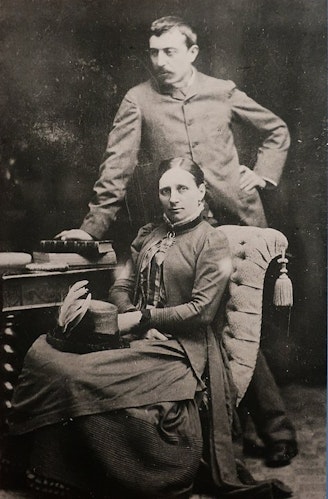
Photo with his wife Mette, 1885
Gauguin's path to becoming a painter
Around 1873, after he began working as a stockbroker, Gauguin began to paint in his spare time.
In the 9th arrondissement of Paris, where he lived, there were many cafes where Impressionist painters gathered, and Gauguin visited galleries and purchased works by emerging artists.
He became acquainted with Camille Pissarro and began visiting Pissarro's house on Sundays to paint together in the garden.
Pissarro introduced him to various other painters as well.
In 1876, one of Gauguin's paintings was selected for the Salon. This led him to set up a studio in his home and to devote himself to painting at a level beyond that of a hobbyist.
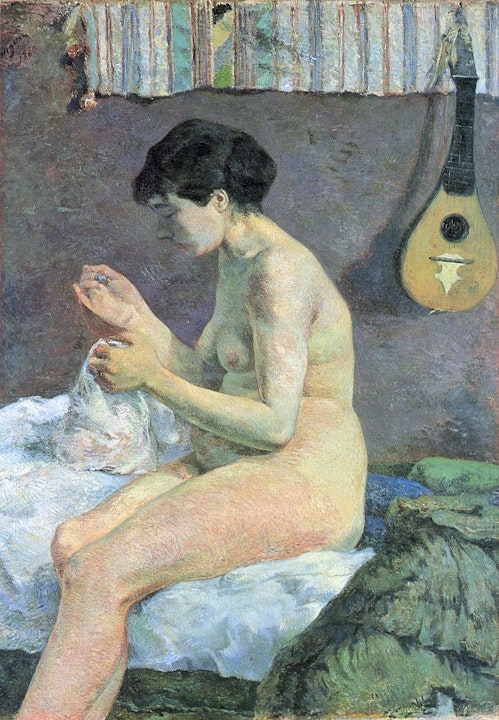
Study of a Nude (Suzanne sewing), 1880
Turn as a painter
In 1882, the Paris stock market crashed. Gauguin's income plummeted, and he began to think about turning painting into his main occupation.
He spent time with Pissarro and Cézanne, with whom he had been friends for some time, and sent letters to Pissarro asking for advice. His wife, Mette, took this opportunity to return to her native Copenhagen, Denmark.
Gauguin himself lived in Copenhagen for a time, but returned to his life in Paris.
Although various circumstances, including the illness of his son, made it difficult for him to devote himself to his work, he gradually broke away from the central impressionist style of Pissarro and others, and began to develop his own symbolist style, which would later be called "Croizonism" or "Syntheticism.
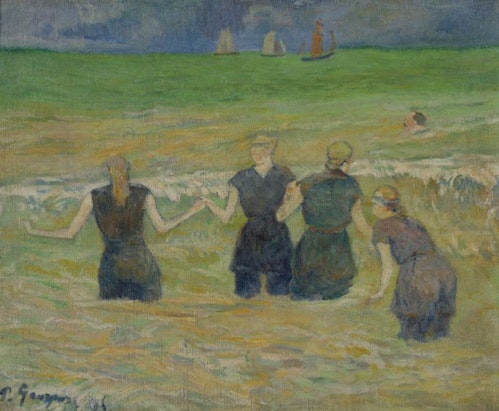
Women Bathing, 1885
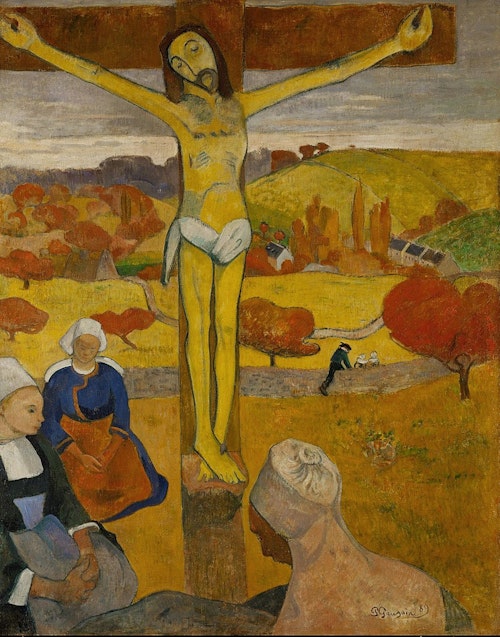
The Yellow Christ (Le Christ jaune), 1889, a representative work of Croizonism
Life in the community of Pont-Tavern
In 1886, Gauguin spent a summer in Pont-Tavern in Brittany, northwestern France. He moved there because of the low cost of living, but his interactions with the young painters who made up the community proved to be an unintended benefit.
In Pont-Tavern, which he would later visit many times, he interacted with painters such as Charles Laval, Emile Bernard, and Emile Scheffnecker.
Their paintings are characterized by their bold use of pure colors and symbolic subjects.
Gauguin adopted their style as a reaction to the excessive emphasis on realism and lack of symbolic depth in traditional European painting leading up to Impressionism.
He also looked to African and Asian art for its heavy use of mythological and symbolic expression.
.jpg?w=500&h=405)
Charles Laval, Self Portrait, 1888
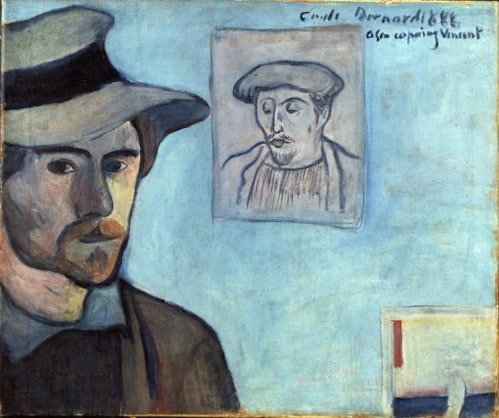
Emile Bernard, Self Portrait with Portrait of Paul Gauguin in the Background, 1888

Emile Schefnecker, Synthetist landscape, c.1900
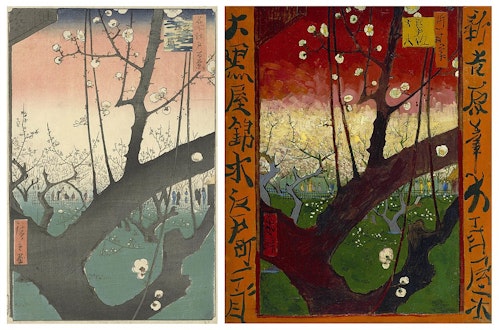
Van Gogh, a painter greatly influenced by Japonism, copy of Ukiyoe by Hiroshige Utagawa, 1887
Trip to Martinique Island
In 1887, Gauguin spent about six months on the Caribbean island of Martinique, one of France's overseas departments, with his friend Charles Laval, whom he had met in Pont-Tavern.
Despite suffering from dysentery and malaria, he painted bright scenes outdoors and incorporated Indian motifs, bringing a new perspective to Gauguin.
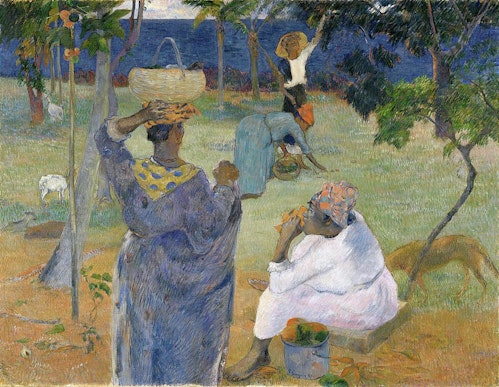
Picking Mangoes, 1887
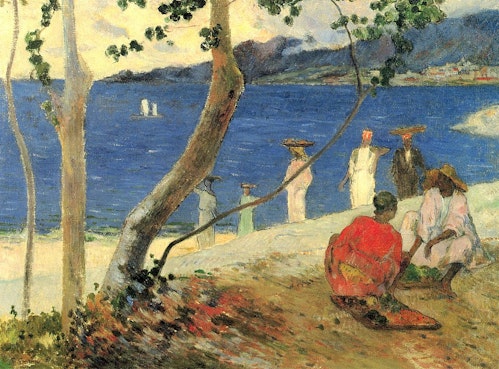
Bord de Mer II, 1887
Living with Van Gogh
The works produced in Martinique were exhibited in the store of the paint dealer Arsène Poitiers.
Vincent van Gogh, who was also doing business there, was deeply impressed by Gauguin's paintings, and a friendship between the two legendary painters began. The two artists began a deep exchange of letters, exchanging artistic ideas and painting portraits of each other.
In 1888, Van Gogh and Gauguin began living together for three months at Van Gogh's "yellow house" in Arles in southern France. However, their views on art did not mesh at all, and their relationship soon deteriorated, prompting Gauguin to leave.
On December 23 of the same year, Van Gogh had his ear cut off. According to Gauguin's later recollections, Van Gogh came at him with a razor blade, and he shouted at him to turn him away.
The next day, van Gogh was sent to a hospital in Arles, and Gauguin left the area.
.jpg?w=500&h=558)
Van Gogh's painting of Gauguin
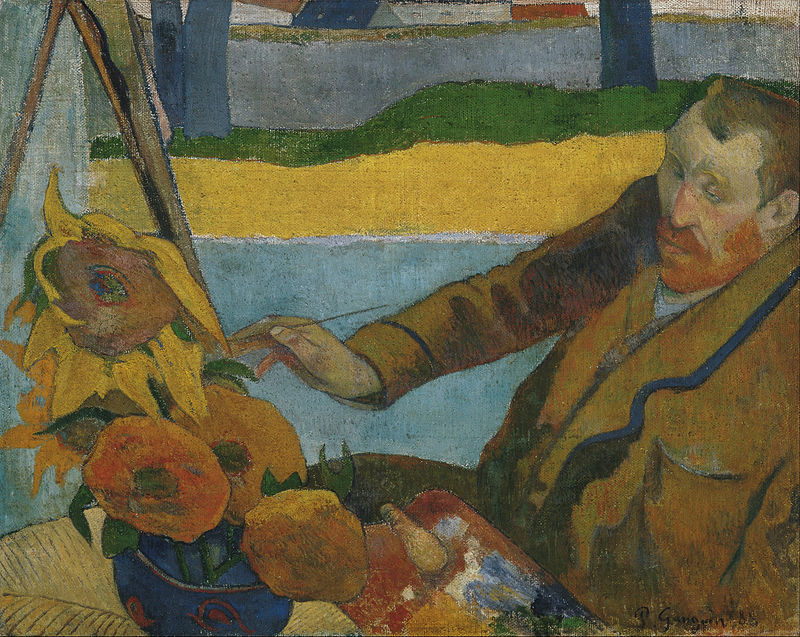
Van Gogh painted by Gauguin
First stay in Tahiti
In an attempt to escape European civilization and "everything artificial and conventional," Gauguin traveled to the island of Tahiti, located in Polynesia.
It was during this period that many of Gauguin's masterpieces were created.
Later, Gauguin wrote a travelogue entitled "Noa Noa" based on this stay.
Initially perceived as a commentary on his paintings and an account of his experiences in Tahiti, the book has since been accused of fanciful imaginings and plagiarism.
In the book, he reveals that he was married there to a 13-year-old girl named Tehermana (known as Tehura), who was pregnant with Gauguin's child in the summer of 1892, but reportedly miscarried.
She returned to Paris and held exhibitions, but they did not sell well. She also lost her business with Durand-Ruel, an art dealer, and other hardships followed, most notably the breakup with his wife, Mette. They continued to bicker over muddled financial matters, and they never saw each other again.
Second Time in Tahiti
Isolated from the Paris art world by critical articles written by his former friend Emile Bernard and the poet and art critic Mauclair, Gauguin once again fled to Tahiti in 1895.
In his second visit to Tahiti, he gradually stabilized his life and became a contributor to and later editor of a local magazine. His articles were characterized by foul-mouthed attacks on the governor and bureaucrats, but he was never a defender of indigenous rights.
Gauguin's health gradually deteriorated, and he suffered from broken bones and syphilis.
At the same time, he was married during this period to Paula, a 14-year-old girl at the time, with whom he had two children.
Residence in the Marquesas Islands and death
In search of a more primitive society, Gauguin traveled further from Tahiti to the Marquesas Islands.
In fact, the Marquesas were the most Westernized of the Pacific islands, with a population of 80,000 in the 18th century that had dwindled to 4,000 by then.
Like Tahiti, the islands had been westernized and had already lost their unique culture.
Gauguin took up residence there and once again took a 14-year-old girl, Vaejo, as his wife, and continued to work energetically while she nursed him through his deteriorating health.

Marquise Man in Red Cape, 1902
In 1902, Gauguin's failing health led him to write a journal entitled "Before and After," a miscellany of art criticism and personal dislike of the local priest, his ex-wife Met, and the Danish people in general.
He died suddenly on the morning of May 8, 1902, perhaps due to his continued reliance on morphine and other drugs.
During that period, he was engaged in a campaign to denounce the local military police, and was sued for libel for doing so.
A glance at Gauguin's stylistic changes!
Still-Life with Fruit and Lemons
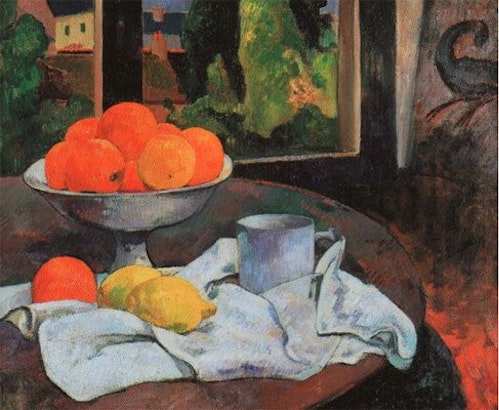
Still-Life with Fruit and Lemons, c. 1880
Gauguin, who began his painting career as an adult, attempted a methodical approach to composition, which is indicative of the seriousness of his stockbroker days.
Four Breton Women Dancing
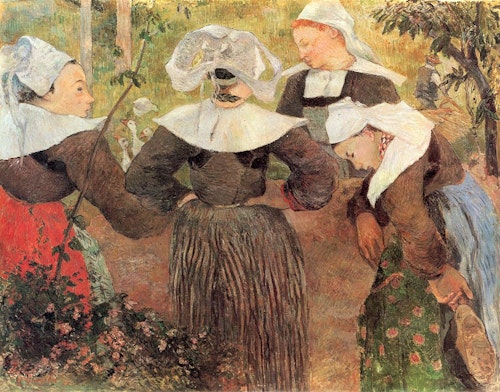
Four Breton Women, 1886
Also known as Croizonism or Compositivism, this painting is characterized by its extensive use of outlines and primary colors.
Woman with a Flower
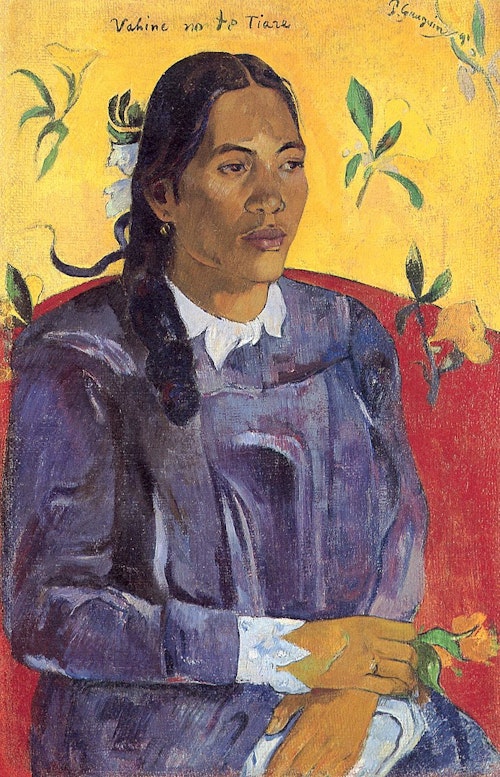
Vahine no te tiare (Woman with a Flower), 1891
Spirit of the Dead Watching
.jpeg?w=500&h=394)
Spirit of the Dead Watching, 1892
Oviri (sculpture)
%2C_partially_glazed_stoneware%2C_75_x_19_x_27_cm%2C_Muse%CC%81e_d'Orsay.jpg?w=500&h=787)
Oviri (Sauvage), 1894
In Tahiti, Gauguin was exposed to a primitive society. He used ethnic groups with different skin tones and customs that seemed novel as motifs, and developed a third-party perspective on tribal society.
Such a perspective is now obtained by people such as cultural anthropologists, who enter and integrate into the society for research purposes. How did Gauguin see himself as a Westerner who conquered and Westernized the South Island?
Mahana no atua
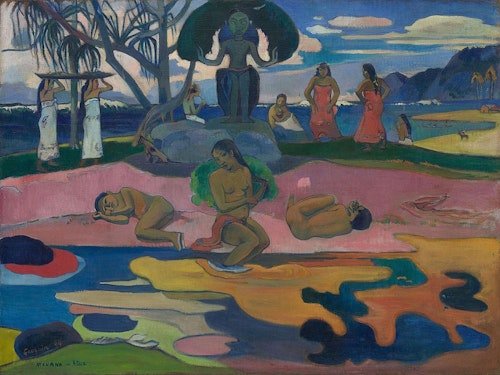
Mahana no atua (Day of the God), 1894
Where did we come from, who are we, where are we going?
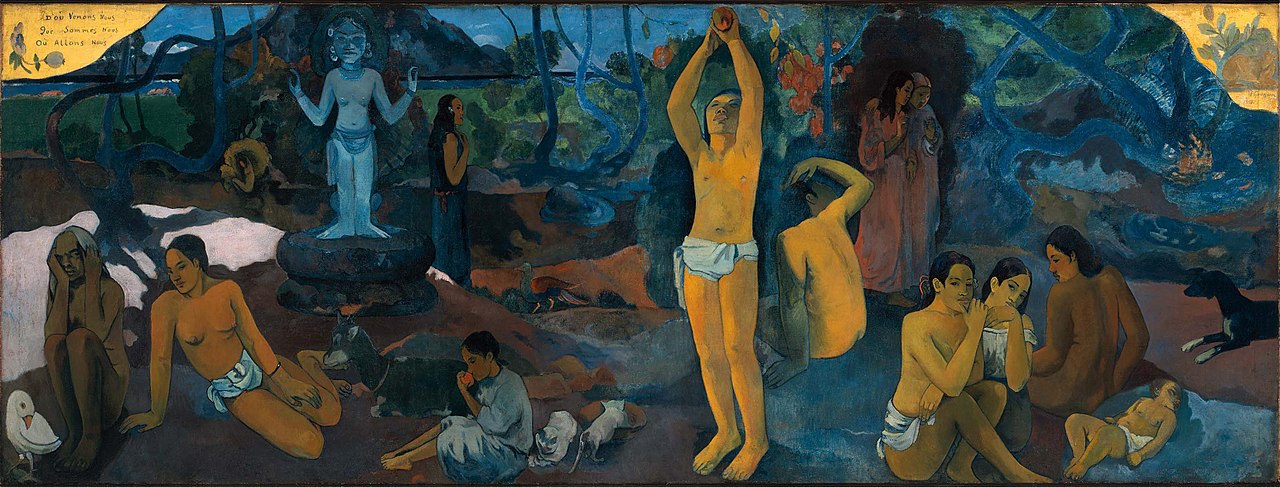
Where We Came From, Who We Are, Where We Are Going, 1897
Gauguin's masterpiece. The title evokes a profound philosophical theme, evoking the myths and narratives passed down in the primitive society of Tahiti. This work is explained in detail in the following article.
Where Did We Come From, Who Are We, and Where Are We Going? Gauguin's masterpiece explained!
Still life with parrots
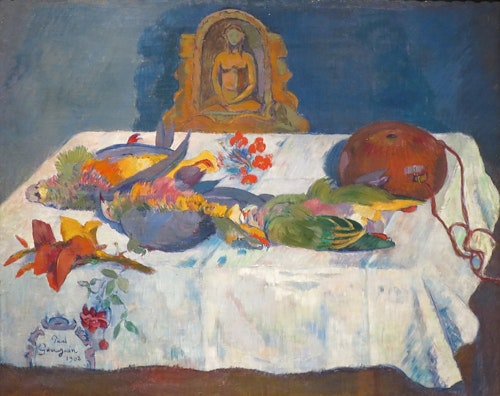
Still life with Exotic Birds, 1902
Also read
Please also read these articles related to Gauguin.
Where Do We Come From, Who Are We, and Where Are We Going? The explanation of Gauguin's masterpieces!
Art Course 2: Modern Art, Part 2: From Post-Impressionism to the Influence of Modernity
What is Impressionism? - Transition of Light and Space
Post-Impressionism: Paintings No One Has Seen Before
Symbolism: To Hear the Silent Whisper of the Soul
Art Lecture 10] Navier School: Prophets of Abstract Expression
TRiCERA ART members receive a variety of special offers and preferences.
- Discounts, including members-only secret sales and coupons
- Create your own collection by registering your favorite artists
- Receive updates on popular artists, exhibitions, and events
- Receive a weekly newsletter with selected art
- Personal Assessment to find out what kind of art you like.
Please register as a member for free and receive the latest information.
Free Member Registration